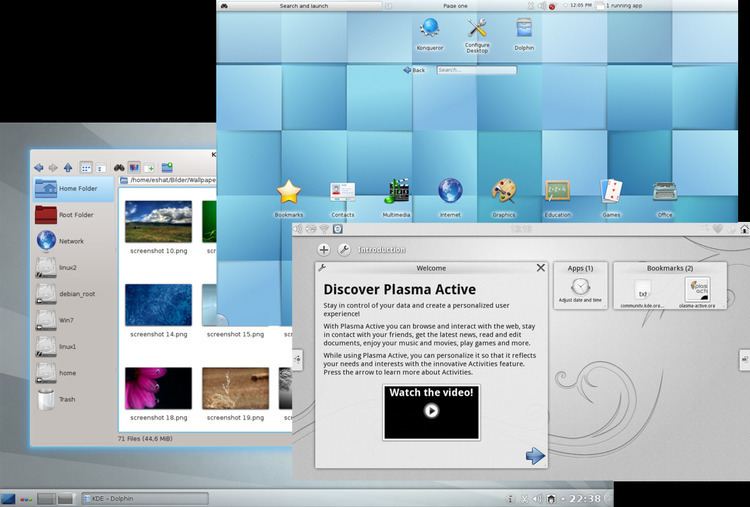Development status Discontinued | ||
 | ||
Initial release January 11, 2008; 9 years ago (2008-01-11) Stable release 4.11.22 (19 August 2015; 18 months ago (2015-08-19)) [±] Repository quickgit.kde.org?p=kde-workspace.git | ||
KDE Plasma 4, subsequently renamed from KDE Plasma Workspaces, is the umbrella term for the fourth generation graphical environments provided by KDE. It consists of three workspaces, each targeting a certain platform: Plasma Desktop for traditional desktop PCs and notebooks, Plasma Netbook for netbooks, and Plasma Active for tablet PCs and similar devices.
Contents
KDE Plasma 4 was released as part of KDE Software Compilation 4 and replaced Kicker, KDesktop, and SuperKaramba, which formed the Desktop in earlier KDE releases. They are bundled as the default environment with a number of free software operating systems, such as Chakra, Kubuntu, Mageia (DVD version), openSUSE, or TrueOS.
With the release of KDE SC 4.11 on 14 August 2013, KDE Plasma 4 was placed into a feature freeze and turned into a long-term stable package until August 2015. On 15 July 2014 KDE Plasma 4’s successor, KDE Plasma 5, was released.
Features
Plasma features containments, which are essentially applets that contain other applets. Two examples of containments are the desktop background and the taskbar. A containment can be anything the developer wants: an image (either raster graphics or an SVG image), animation, or even OpenGL. Images are most commonly used, but with Plasma the user could set any applet as the desktop background without losing functionality of the applet. This also allows for applets to be dragged between the desktop and the taskbar (two separate containments), and have a separate visualization for the more confined taskbar.
Plasma separates components into "data engine" and their visualization counterparts. This is intended to reduce the total programming effort when there are multiple possible visualizations of given data; and to make it easier for the data engine and the workspaces to be written independently.
The scalable nature of the Plasma widgets allows for them to be resized and rotated to any size, with only a brief pause to redraw themselves. The Kross scripting framework allows developers to write widgets in a variety of programming languages in addition to C++.
KRunner is a versatile tool for several functions. It replaces the dialog box "Run Command" from K Desktop Environment 3, and also inherits from the application launcher feature, expanding the possibilities through a modular plug. KRunner stores previously entered commands and searches, accessible via an auto-complete feature. KRunner can be shown on the desktop via the keyboard combination Alt+F2 or by selecting "Run Command ..." in the desktop menu.
These functions are handled by the plugin:
Desktop
Plasma Desktop is the first workspace that was developed by KDE. It was declared mature with the release of KDE SC 4.2. It is designed for desktop PCs and larger laptops. In its default configuration it resembles K Desktop Environment 3 and Microsoft Windows XP but extensive configurability allows radical departures from the default layout.
Its technology is a fundamental rewrite of several desktop interaction programs included in previous KDE desktop environments for Unix-like systems, focusing on eye candy and special graphical effects. The Desktop Workspace replaces the previous KDesktop shell, Kicker taskbar and SuperKaramba widget engine used in the K Desktop Environment 3 series with a unified system of widgets that can be configured and replaced with alternative designs.
From KDE 4.0 to KDE 4.2, the default theme Oxygen was characterized by dark tones. In KDE 4.3, replaced by the new Air theme, which predominates in transparency and white as base color. New themes for Plasma can be chosen and installed through an authority.
Supported widgets
This is a list of widgets that the current release version of Plasma supports. Not all widgets are supported by default in all Linux distributions; some may require different packages, or even a recompilation of Plasma.
Previous Plasma Workspaces releases also supported Edje gadgets and E17 modules. Support for those was developed in 2008 but later, in 2010, removed.
Google Gadgets were also supported. After Google announced to discontinue its two services that utilize Gadgets – Google Desktop and iGoogle – KDE removed support for this widget engine in early 2013.
Netbook
Plasma Netbook is the second workspace. It aims at netbooks and may also be used on tablet PCs. The first stable release shipped with KDE SC 4.4.
Plasma Active
Plasma Active is a software bundle for devices with touchscreens. It not only encompasses a Plasma Workspace but also includes several applications such as Kontact Touch and a document viewer based on Calligra Suite.
Contour
Contour is the Plasma interface for tablet devices. Its development was initiated in April 2011 by basysKom. Replacing an earlier tablet prototype, Contour is now the main workspace and was shipped as part of Plasma Active 1.0 in October 2011.
Mobile
Plasma Mobile was targeted at smartphones and small tablet devices that are mainly used via touch input. It was originally expected to be released in 2011 along with Plasma Active 1.0 but development focus shifted towards Contour. A new version with the same name but based on KDE Frameworks 5 has been announced on 25 July 2015.
